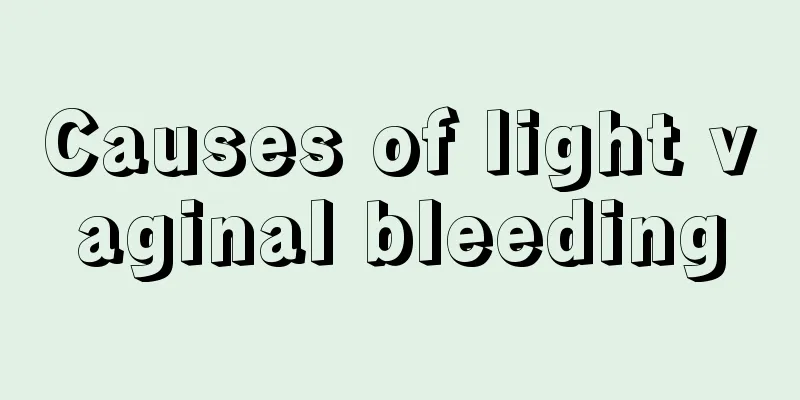If you have paronychia, you should treat it as soon as possible. Once it gets worse, it will be troublesome.

|
Reviewer: Zhang Shuyuan, Chief Physician, Beijing Huayi Integrated Traditional Chinese and Western Medicine Dermatology Hospital Xiaojia had a hangnail on the side of her fingernail. At first, she didn't pay much attention to it and just pulled it off with her hand. However, she didn't expect that after pulling off the hangnail, the side of the nail would be very painful and became red and swollen. Xiaojia rushed to the hospital for treatment. The doctor said she had paronychia. If she waited any longer for treatment, it might become festered and even spread under the nails. So, what is paronychia? Why can it lead to such serious consequences if you don't pay attention to it? 1. What is paronychia Paronychia is an inflammatory reaction of the skin tissue around the nails of the hands and feet. There are many causes of paronychia, such as punctures and bruises on the skin around the nails, tearing off barbs, cutting the nails too deep, or prolonged contact with irritants and allergens, which can cause bacterial infection and lead to paronychia [1]. When paronychia first occurs, one side of the nail will experience slight pain and redness. If not treated in time, it may become suppurative, and the pus will spread to the other side of the nail or under the nail, forming an abscess under the nail, and even yellow-white pus can be seen. The abscess will eventually cause the nail to separate from the nail bed, and then the only option is to remove the nail surgically. Figure 1 Copyright image, no permission to reprint As the saying goes, the fingers are connected to the heart. A seemingly insignificant action may result in unbearable pain. Therefore, once you find pain, redness, and swelling on the edge of your nails, you must pay attention to it and treat it in time to prevent paronychia from getting worse. So, how to treat paronychia? 2. How to treat paronychia According to the duration of the disease, paronychia can be divided into acute and chronic. Acute paronychia usually causes acute pain and swelling within a few days after the nail is injured, followed by a purulent infection, but it can be cured quickly if treated in time. Chronic paronychia is usually caused by bacterial infection caused by long-term contact with water, irritants and allergens, causing inflammation of the skin around the nail, which may even last for weeks and requires longer treatment time [1]. 1. Treatment of acute paronychia (1) Early stage of paronychia In the early stages of paronychia, there may only be a little redness, swelling and pain in the area, but no suppuration. At this time, conservative treatment (non-surgical treatment) can be adopted, using iodine tincture to kill bacteria, and most people will not have an allergic reaction. Gently wipe the affected area and the surrounding area, but do not disinfect the affected area back and forth to avoid secondary infection [2]. If the inflammation has not been relieved, you can use antibiotics topically under the guidance of a doctor, such as mupirocin ointment, gentamicin ointment, polymyxin B ointment, etc. on the affected area[1]. When using topical medications, be sure to keep the affected area clean and avoid contact with water. You can use iodine or saline to rinse it[2]. (2) Purulent paronychia If conservative treatment is ineffective and the affected area has become infected or suppurated, it is necessary to drain the pus, reduce swelling and inflammation in time. You can first try to massage and squeeze the affected area to squeeze out the pus from the wound. If there is no improvement in 2 to 3 days or the wound worsens, the doctor will perform drainage according to the patient's actual situation, cut the affected area open and drain the pus. (3) Late stage of paronychia If the paronychia is very severe and drainage is ineffective, surgery is required. The doctor will remove the entire nail or part of the nail according to the situation, drain the pus, and then reconstruct the nail groove. After a while, the nail will grow back. If the pus is fully drained, oral antibiotics are usually not required. Soak the affected finger with warm water 2 to 3 times a day for 2 to 3 days. 2. Treatment of chronic paronychia For chronic paronychia, patients should first avoid soaking their nails in water or contacting irritants for a long time, and control potential risk factors for inflammation and infection. Secondly, you can use local glucocorticoids, such as betamethasone, for better results. If the drug is not effective, surgery can also be used. Regardless of the type of paronychia, it can be cured with proper measures, but the recurrence rate of paronychia is high due to the high chance of bacterial infection [1]. Therefore, prevention of paronychia is of vital importance. 3. How to prevent paronychia 1. Treat skin wounds promptly If there is a wound on the skin around the nail, it should be cleaned in time and disinfected with iodine. It is best to bandage it with sterile gauze to avoid wound infection. 2. Don’t do manicures too often During the manicure process, the manicurist will trim the dead skin around the customer's nails, causing many small wounds that are invisible to the naked eye in the nail groove. If you are not careful, it may become infected and cause paronychia. If the manicure tools are not strictly disinfected, it can also cause infection. Therefore, do not do manicures too frequently, and be sure to go to a professional and regular beauty salon. Figure 2 Copyright image, no permission to reprint 3. Develop good living habits In daily life, we should keep our hands and feet clean. After washing hands and feet, we should apply skin cream to protect the skin of hands and feet to avoid hangnails in the nail grooves. If there are hangnails in the nail groove, cut them off with a nail clipper. Do not tear them off with your hands, otherwise it will easily cause wounds and even bleeding. Trim your nails regularly, but don’t cut them too short. Get rid of bad habits like sucking, biting, or tearing your nails. Wear suitable, lightweight shoes and loose, breathable, and clean socks to avoid squeezing your toes and causing your nails to become ingrown.[1] The prevention of paronychia should be approached from multiple aspects and factors that may damage the skin around the nails should be avoided to nip the risk in the bud. In daily life, the incidence of paronychia is very high, so we should not only understand the causes and treatments of paronychia, but also develop good living habits, so as to fundamentally reduce the risk of paronychia and protect the health of the nails. References 【1】Song Jianbo. What to do if you have paronychia. Family Medicine. Seeking Medical Treatment and Selecting Medicines, 2022(4):60. 【2】Zhang Wenhe. Zhang Wenhe Skin Care Guide. Beijing: Science and Technology Literature Press, 2021. |
>>: Is it better to wear braces or invisible braces to straighten teeth?
Recommend
Why do I still have vaginal discharge after menopause?
In healthy women, more vaginal discharge is direc...
Back pain around five months of pregnancy
After five months of pregnancy, lower back pain i...
How many days after medical abortion?
Most women who have an unexpected pregnancy will ...
There are eight key points for winter health preservation from Xiaoxue to Yi
November 22, 2020 (the eighth day of the tenth lu...
What are the feet of a snail called? What are the teeth of a snail called?
Snails are a group of animals that include many d...
What are the dangers of breast cysts?
I believe everyone has heard of diseases like bre...
What are the benefits of drinking a glass of watermelon juice every day? Does drinking watermelon juice cause internal heat?
Watermelon juice is a very popular and fashionabl...
Why does a woman's genitals turn black?
In daily life, women will experience a process wh...
What should I bring when taking a hot spring bath? The complete steps of taking a hot spring bath
Recently, it is a good time for people to relax a...
Can excessive menstruation cause anemia?
Menstruation is a very normal physiological pheno...
What should I eat if I have irregular menstruation?
Diet has always had many benefits for people'...
What happens if you have sex too early after an abortion?
The new generation of men and women focus on thei...
White discharge a bit reddish brown
Leucorrhea is a physiological phenomenon that man...
How to calculate the safe menstrual period for girls
For female friends, it is very necessary to under...
![[Health Science] A chart to understand the best time to take common oral hypoglycemic drugs](/upload/images/67f124abc2dfb.webp)








